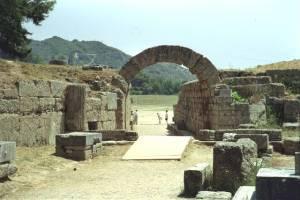Olympia ...more on Olympia
... The most celebrated temple was the Temple of Zeus, dedicated to the father of the gods. In this temple was a statue of Zeus, 12 m (40 ft) in height, made of ivory and gold, one of the seven wonders of the ancient world. Next to the Temple of Zeus ranked the Heraeum, dedicated to Hera, the wife of Zeus. In this temple, probably the oldest Doric building known, stood the table on which were placed the garlands prepared for the victors in the games. The votive buildings included a row of 12 treasure houses and the Philippeum, a circular Ionic building dedicated by Philip II, king of Macedonia, to himself. The monument was restored lately, when the German authorities returned half of its architectural members which they lawfully held, for them to be used together with the ones held by the Greek State to make a full restoration in situ possible. Outside the Altis, to the east, were the Stadium and the Hippodrome, where the contests took place; on the west were the Palaestra, or wrestling school, and the Gymnasium, where all competitors were obliged to train for at least one month. The most celebrated temple was the Temple of Zeus, dedicated to the father of the gods. In this temple was a statue of Zeus, 12 m (40 ft) in height, made of ivory and gold, one of the seven wonders of the ancient world. Next to the Temple of Zeus ranked the Heraeum, dedicated to Hera, the wife of Zeus. In this temple, probably the oldest Doric building known, stood the table on which were placed the garlands prepared for the victors in the games. The votive buildings included a row of 12 treasure houses and the Philippeum, a circular Ionic building dedicated by Philip II, king of Macedonia, to himself. The monument was restored lately, when the German authorities returned half of its architectural members which they lawfully held, for them to be used together with the ones held by the Greek State to make a full restoration in situ possible. Outside the Altis, to the east, were the Stadium and the Hippodrome, where the contests took place; on the west were the Palaestra, or wrestling school, and the Gymnasium, where all competitors were obliged to train for at least one month.
The French began excavations here in 1829, two years after the battle of Navarino. The finds (metopes from the opisthodomus and parts of the metopes from the pronaos of the Temple of Zeus) were transferred to the Louvre where they are still being exhibited. When the Greek government was informed of the looting of artifacts, the excavation was stopped. German explorations of 1875-81 threw much light upon the plans of the buildings; they were resumed in 1936, 1952, and 1960-61. Many valuable objects were discovered, the most important of which was a statue of Hermes, the messenger of the gods, by Praxiteles.
Concluding, the prospective visitor must be informed that the importance of this site, revered throughout the world, makes a visit to it "obligatory", as its beauty has only very detrimentally been affected by the recent fires and no archaeological treasure, in and outside the new Museum, has been harmed.
|
|



